Orders placed on LazMart Philippines, usually scheduled for next-day deliveries, now take one to two weeks to arrive.
Staffing is also a problem for many delivery services in heavily-quarantined markets. Many workers in the Philippines had decided to stay home just as panic buying set in before the lockdown. Filipino consumers flocked to supermarkets to stock up, emptying grocery shelves. Alcohol and toilet paper quickly became scarce. Once the lockdown was enforced, this deluge of purchases spilled over online.
“For us, [the factors behind the delays] include an increase in orders, a leaner workforce, as well as ensuring staff safety while following safe distancing and hygiene protocols in the workplace,” a Lazada spokesperson tells us.
Closed Signals of Desire

Grab, whose Grabfood was cited as the most used food delivery platform by 76% of Filipinos in a 2019 survey, doesn’t have enough drivers to meet the demand in the Philippines. This has increased booking wait times for users across its food and grocery delivery services.
“In some markets, delivery demand is higher than existing supply capacity,” said the Grab spokesperson. In others, such as Malaysia, both demand and supply have gone up. That’s because the Malaysian government lets four-wheel drivers switch to delivery services—something that countries like Singapore prohibit. However, Singapore has run trials allowing 4-wheeled drivers to deliver food and other goods in certain areas.
“We try to navigate different policies that are in place in Southeast Asia. In cases where supply is low, we leverage our tech – we optimise the routes so our drivers become more productive,” added the spokesperson.
RedMart, meanwhile, has tried to catch up by moving away from time-based delivery slots to area-based slots. This has allowed it to complete 4X more orders.
What is Fruit Forward Fashion and How Does it Actually Work?
Responding to surging demand, fashion marketplace Zalora branches into online grocery, adding ‘essentials’ as category.
…and opportunity brings risk…
Despite the challenges, there have been plenty of first-time adopters. At zero to minimal marketing costs, too.
When GrabMart went live in select cities in Metro Manila, “immediately we saw strong demand without any promotions. It’s organic reach,” says another spokesperson interviewed by us.
It’s a similar story for many brands on marketplaces like Lazada and Shopee, where the usual discounts are now hard to come by.
Zagana’s Sy, who also owns Great Deals E-commerce in the Philippines—a company that manages the online distribution for more than 300 brands including food manufacturers—says consumers’ priority is to stock up, not hunt for deals. Great Deals is also a partner-supplier of GrabMart. “People are buying at standard retail prices from our client stores on Lazada and Shopee,” he notes.
That’s not to say that platforms and brands had no intention to spend on marketing. They just reckoned it made no sense to roll out promos to generate massive order volumes that they cannot fulfil anyway because of limited capacity, according to Sy. “You don’t want to put your operations under more stress only to disappoint more customers,” he says.